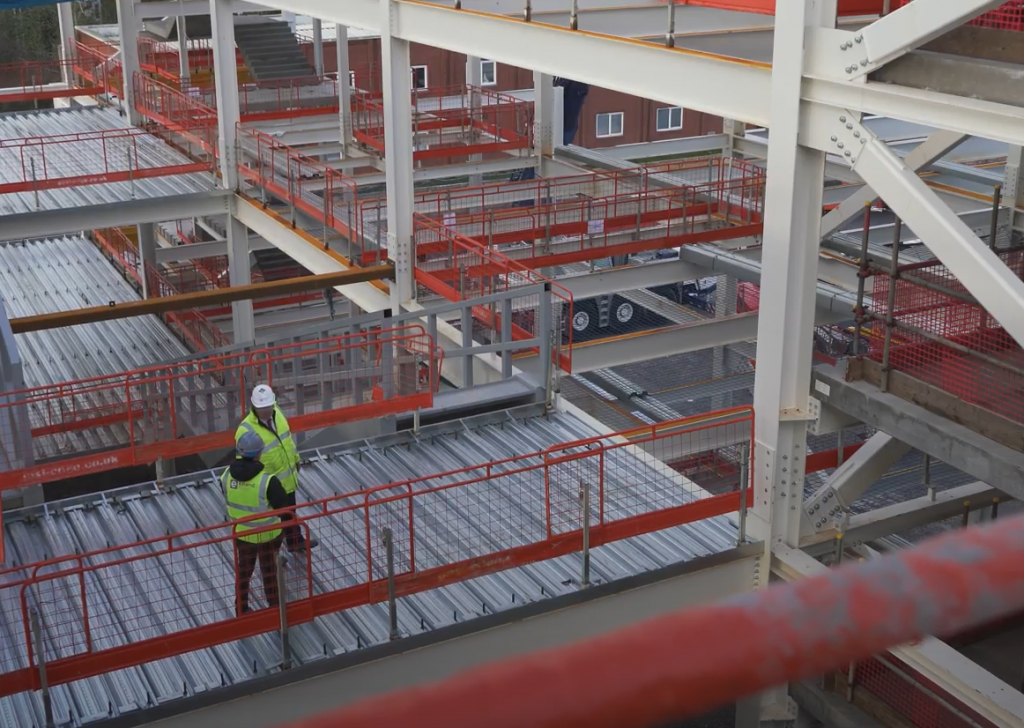Managing sites which are safe and efficient is a core objective for any considerate constructor. To achieve this, collaborative construction techniques are key.
Working on a city centre development with BAM Construction, we used efficient methods to ensure delivery of the steel structure was on-time, on-budget and risk-free.
We were brought in to support with the completion of a 12-storey commercial building in the heart of London’s King Cross. We delivered almost 1,000 tonnes of new and altered steelwork, pre-cast stairs and metal decking for the steel structure, with the 16,000m2 building now housing open plan offices, a double height atrium and expansive balconies, topped with a landscaped roof garden.
The new building was not only sited in a busy area of the capital but was also set to have foundations straddling two Thameslink tunnels, necessitating careful planning and engineering of the foundational structure and frame. In fact, an initial plan for a concrete structure was scrapped in favour of the cost and weight benefits of a steel structure.
This city centre location also meant innovative methods for unloading deliveries would be necessary for logistics, as well as to meet BAM Construction’s drive for industry-leading safe systems of working.
Having reviewed the BCSA’s RIDDOR records (Reporting of Injuries, Diseases and Dangerous Occurrences Regulations) for our sector, we had identified some of the most common accidents in order to mitigate the risk of similar incidents occurring on site. These records included 14 injuries caused during handling, carrying or lifting and seven injuries caused by falls from a height. As such, we focused efforts on eliminating the potential for handling injuries and reducing the risks of working at height.
To do so, we employed a pre-slinging methodology for the receipt of materials on site. By having the required lifting slings attached to materials ahead of transport for delivery, we made them accessible for the on-site team to minimize handling upon delivery and negated the need for teams to climb on to the vehicle.
Pre-slinging in this way made the logistics of the materials delivery simpler, reduced the risk of handling damage or safety risk, and sped up the overall process of receiving the items. With experience in using this method, we were able to design slinging which worked with the lifting and space constraints of the location and had staff on-site trained in the method.
As well as mitigating the risks highlighted from the RIDDOR records this method also reduced the risk of injury from poorly loaded loads, slips, trips or falls on or off the lorry and crushing or entrapment.
And by streamlining the off-loading processing, pre-slinging not only delivered safety benefits but also efficiencies – suiting the organisation of the limited confines of the site. By reducing the frequency of higher risk activities around off-loading it reduced the overall time spent managing deliveries and handling or storing materials.
The decision to pre-sling loads was made early on in the project, giving us sufficient time to carefully plan the activity and build a sequence for receiving and unloading the materials in line with the build sequence. This meant that each part of the steel structure was carefully planned from supplier to fabricator to painter to site. This truly collaborative construction method allowed BAM to effectively ‘build off the lorry’, as vehicles working to just in time tactics brought in exactly the materials as required on site on a given day. A trial of the activity, for one month, allowed for close monitoring of its application and effectiveness ahead of full roll-out.
Working in this way ensured all works were completed on time and with no accidents. BAM Construction also spoke of the value this approach for the steel structure offered to its relatively young site team, with a number of apprentices witnessing and learning from the activity and its benefits.
Collaboration was key, with BAM both supporting and challenging us to refine and perfect the strategy while we remained flexible and open to learning.
The building has since been awarded an outstanding BREEAM rating for its high levels of sustainability while we have been nominated for an award by BAM Construction, for Best Safety Partnership in the National Health & Safety Awards 2020.
Visit our Projects pages to learn more about our commitment to collaborative construction strategies.

